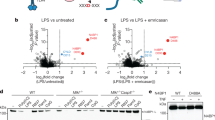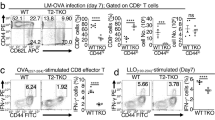Abstract
The TPL-2 MEK kinase is essential for activation of the Erk MAP kinase pathway during innate immune responses. TPL-2 is found in complex with ABIN-2 (A20-binding inhibitor of NF-κB 2). Here, using antigen-presenting cells from ABIN-2-deficient mice, we show that ABIN-2 was required for optimal activation of Erk induced by receptors that signal via TPL-2, including Toll-like receptor 4 and tumor necrosis factor receptor 1 in macrophages, and CD40 in B cells. ABIN-2 was necessary for the maintenance of TPL-2 protein stability. In contrast, ABIN-2 deficiency did not affect agonist-induced regulation of transcription factor NF-κB. Stimulation of ABIN-2-deficient macrophages via Toll-like receptor 4 showed that different thresholds of Erk signaling were required for optimal induction of tumor necrosis factor and interleukin 1β. Thus, ABIN-2 acts to positively regulate the Erk signaling potential by stabilizing TPL-2.
This is a preview of subscription content, access via your institution
Access options
Subscribe to this journal
Receive 12 print issues and online access
$209.00 per year
only $17.42 per issue
Buy this article
- Purchase on Springer Link
- Instant access to full article PDF
Prices may be subject to local taxes which are calculated during checkout









Similar content being viewed by others
References
Takeda, K., Kaisho, T. & Akira, S. Toll-like receptors. Annu. Rev. Immunol. 21, 335–376 (2003).
Wajant, H., Pfizenmaier, K. & Scheurich, P. Tumor necrosis factor signaling. Cell Death Differ. 10, 45–65 (2003).
Karin, M. & Ben-Neriah, Y. Phosphorylation meets ubiquitination: the control of NF-κB activity. Annu. Rev. Immunol. 18, 621–663 (2000).
Beinke, S. & Ley, S.C. Functions of NF-κB1 and NF-κB2 in immune cell biology. Biochem. J. 382, 393–409 (2004).
Beyaert, R., Heyninck, K. & van Huffel, S. A20 and A20-binding proteins as cellular inhibitors of nuclear factor-κB-dependent gene expression and apoptosis. Biochem. Pharmacol. 60, 1143–1151 (2000).
Boone, D.L. et al. The ubiquitin-modifying enzyme A20 is required for termination of Toll-like receptor responses. Nat. Immunol. 5, 1052–1060 (2004).
Lee, E.G. et al. Failure to regulate TNF-induced NF-κB and cell death responses in A20-deficient mice. Science 289, 2350–2354 (2000).
van Huffel, S., Delaei, F., Heyninck, K., de Valck, D. & Beyaert, R. Identification of a novel A20-binding inhibitor of nuclear factor-κB activation termed ABIN-2. J. Biol. Chem. 276, 30216–30223 (2001).
Hughes, D.P., Marron, M.B. & Brindle, N.P. The anti-inflammatory endothelial tyrosine kinase Tie2 interacts with a novel nuclear factor-κB inhibitor ABIN-2. Circ. Res. 92, 630–636 (2003).
Sun, L. & Chen, Z.J. The novel functions of ubiquitination in signaling. Curr. Opin. Cell Biol. 16, 119–120 (2004).
Wertz, I.E. et al. De-ubiquitination and ubiquitin ligase domains of A20 downregulate NF-κB signalling. Nature 430, 694–699 (2004).
Lang, V. et al. ABIN2 forms a ternary complex with TPL-2 and NF-κB1 p105 and is essential for TPL-2 protein stability. Mol. Cell. Biol. 24, 5235–5248 (2004).
Patriotis, C., Makris, A., Bear, S.E. & Tsichlis, P.N. Tumor progression locus 2 (Tpl-2) encodes a protein kinase involved in the progression of rodent T cell lymphomas and in T cell activation. Proc. Natl. Acad. Sci. USA 90, 2251–2255 (1993).
Miyoshi, J., Higashi, T., Mukai, H., Ohuchi, T. & Kakunaga, T. Structure and transforming potential of the human cot oncogene encoding a putative protein kinase. Mol. Cell. Biol. 11, 4088–4096 (1991).
Dumitru, C.D. et al. TNFα induction by LPS is regulated post-transcriptionally via a TPL2/Erk-dependent pathway. Cell 103, 1071–1083 (2000).
Eliopoulos, A.G., Wang, C.C., Dumitru, C.D. & Tsichlis, P.N. TPL-2 transduces CD40 and TNF signals that activate Erk and regulates IgE induction by CD40. EMBO J. 22, 3855–3864 (2003).
Salmeron, A. et al. Activation of MEK-1 and SEK-1 by Tpl-2 proto-oncoprotein, a novel MAP kinase kinase kinase. EMBO J. 15, 817–826 (1996).
O'Gorman, S., Dagenais, N.A., Qian, M. & Marchuk, Y. Protamine-Cre recombinase transgenes efficiently recombine target sequences in the male germ line of mice, but not in embryonic stem cells. Proc. Natl. Acad. Sci. USA 94, 14602–14607 (1997).
Chen, L.F. & Greene, W.C. Shaping the nuclear action of NF-κB. Nat. Rev. Mol. Cell Biol. 5, 392–401 (2004).
Sun, S.C., Ganchi, P.A., Ballard, D.W. & Greene, W.C. NF-κB controls expression of inhibitor IκBα: evidence for an inducible autoregulatory pathway. Science 259, 1912–1915 (1993).
Baeuerle, P.A. & Henkel, T. Function and activation of NF-κB in the immune system. Annu. Rev. Immunol. 12, 141–179 (1994).
Krappmann, D. et al. The IκB kinase complex and NF-κB act as master regulators of lipopolysaccharide-induced gene expression and control subordinate activation of AP-1. Mol. Cell. Biol. 24, 6488–6500 (2004).
Li, Q. & Verma, I.M. NF-κB regulation in the immune system. Nat. Rev. Immunol. 2, 725–734 (2002).
Sugimoto, K. et al. A serine/threonine kinase, Cot/Tpl2, modulates bacterial DNA-induced IL-12 production and Th cell differentiation. J. Clin. Invest. 114, 857–866 (2004).
Aoki, M. et al. The human cot proto-oncogene encodes two protein serine/threonine kinases with different transforming activities by alternative initiation of translation. J. Biol. Chem. 268, 22723–22732 (1993).
Belich, M.P., Salmeron, A., Johnston, L.H. & Ley, S.C. TPL-2 kinase regulates the proteolysis of the NF-κB inhibitory protein NF-κB1 p105. Nature 397, 363–368 (1999).
Hsu, H.Y. & Wen, M.H. Lipopolysaccharide-mediated reactive oxygen species and signal transduction in the regulation of interleukin-1 gene expression. J. Biol. Chem. 277, 22131–22139 (2002).
Eliopoulos, A.G., Dumitru, C.D., Wang, C.-C., Cho, J. & Tsichlis, P.N. Induction of COX-2 by LPS in macrophages is regulated by TPL2-dependent CREB activation signals. EMBO J. 21, 4831–4840 (2002).
Waterfield, M.R., Zhang, M., Norman, L.P. & Sun, S.-C. NF-κB1 / p105 regulates lipopolysaccharide-stimulated MAP kinase signaling by governing the stability and function of the TPL-2 kinase. Mol. Cell 11, 685–694 (2003).
Guha, M. et al. Lipopolysaccharide activation of the MEK-Erk1/2 pathway in human monocytic cells mediates tissue factor and tumor necrosis factor α expression by inducing Elk-1 phosphorylation and Egr-a expression. Blood 98, 1429–1439 (2001).
Heyninck, K., Kreike, M.M. & Beyaert, R. Structure-function analysis of the A20-binding inhibitor of NF-κB activation, ABIN-1. FEBS Lett. 536, 135–140 (2003).
Zhang, S.Q., Kovalenko, A., Cantarella, G. & Wallach, D. Recruitment of the IKK signalosome to the p55 TNF receptor: RIP and A20 bind to NEMO (IKKγ) upon receptor stimulation. Immunity 12, 301–311 (2000).
Heyninck, K. et al. The zinc finger protein A20 inhibits TNF-induced NF-κB-dependent gene expression by interfering with an RIP- or TRAF2-mediated transactivation signal and directly binds to a novel NF-κB-inhibiting protein ABIN. J. Cell Biol. 145, 1471–1482 (1999).
Beinke, S. et al. NF-κB p105 negatively regulates TPL-2 MEK kinase activity. Mol. Cell. Biol. 23, 4739–4752 (2003).
Bouwmeester, T. et al. A physical and functional map of the human TNFα/NF-κB signal transduction pathway. Nat. Cell Biol. 6, 97–105 (2004).
Beinke, S. et al. Lipopolysaccharide activation of the TPL-2/MEK/Extracellular signal-regulated kinase mitogen-activated protein kinase cascade is regulated by IκB kinase-induced proteolysis of NF-κB1 p105. Mol. Cell. Biol. 24, 9658–9667 (2004).
Akira, S. & Takeda, K. Toll-like receptor signalling. Nat. Rev. Immunol. 4, 499–511 (2004).
Brummer, T., Shaw, P.E., Reth, M. & Misawa, Y. Inducible gene deletion reveals different roles for B-Raf and Raf-1 in B-cell antigen receptor signalling. EMBO J. 21, 5611–5622 (2002).
Sato, S. et al. Essential function of the kinase TAK1 in innate and adaptive immune responses. Nat. Immunol. 6, 1087–1095 (2005).
Woods, D. et al. Raf-induced proliferation or cell cycle arrest is determined by the level of Raf activity with arrest mediated by p21Cip1. Mol. Cell. Biol. 17, 5598–5611 (1997).
Jorritsma, P.J., Brogdon, J.L. & Bottomly, K. Role of TCR-induced extracellular signal-regulated kinase activation in the regulation of early IL-4 expression in naive CD4+ T cells. J. Immunol. 170, 2427–2434 (2003).
Salmeron, A. et al. Direct phosphorylation of NF-κB p105 by the IκB kinase complex on serine 927 is essential for signal-induced p105 proteolysis. J. Biol. Chem. 276, 22215–22222 (2001).
Warren, M.K. & Vogel, S.N. Bone marrow-derived macrophages: development and regulation of differentiation markers by colony-stimulating factor and interferons. J. Immunol. 134, 982–989 (1985).
Morita, S., Kojima, T. & Kitamura, T. Plat-E: an efficient and stable system for transient packaging of retroviruses. Gene Ther. 7, 1063–1066 (2000).
Ranganath, S. et al. GATA-3-dependent enhancer activity in IL-4 gene regulation. J. Immunol. 161, 3822–3826.
Inaba, K. et al. Generation of large numbers of dendritic cells from mouse bone marrow cultures supplemented with granulocyte/macrophage colony-stimulating factor. J. Exp. Med. 176, 1693–1702 (1992).
Lang, V. et al. βTrCP-mediated proteolysis of NF-κB1 p105 requires phosphorylation of p105 serines 927 and 932. Mol. Cell. Biol. 23, 402–413 (2003).
Beinke, S., Belich, M.P. & Ley, S.C. The death domain of NF-κB1 p105 is essential for signal-induced p105 proteolysis. J. Biol. Chem. 277, 24162–24168 (2002).
Alkalay, I. et al. In vivo stimulation of IκB phosphorylation is not sufficient to activate NF-κB. Mol. Cell. Biol. 15, 1294–1301 (1995).
Zheng, Y., Vig, M., Lyons, J., van Parijs, L. & Beg, A.A. Combined deficiency of p50 and cRel in CD4+ T cells reveals an essential requirement for nuclear factor κB in regulating mature T cell survival and in vivo function. J. Exp. Med. 197, 861–874 (2003).
Acknowledgements
We thank T. Kitamura and P. Tsichlis for reagents; S. Beinke and B. Seddon (Division of Immune Cell Biology, NIMR) for critical reading of the manuscript; A. Garefalaki and U. Menzel (Division of Molecular Immunology, NIMR) for help with culturing targeted embryonic stem cells; M. Holman (Division of Immunoregulation, NIMR) for advice on LPS injections; and the NIMR Photographics department, NIMR Biological Services and other members of the Ley laboratory for help during the course of this work. Supported by the UK Medical Research Council and Arthritis Research Campaign (L0549 to A.S. and 16053 to F.K.).
Author information
Authors and Affiliations
Corresponding author
Ethics declarations
Competing interests
The authors declare no competing financial interests.
Supplementary information
Supplementary Fig. 1
Disruption of the Tnip2 gene in mice. (PDF 220 kb)
Supplementary Fig. 2
Survival and proliferation of B and T cells are unaffected by ABIN-2 deficiency. (PDF 198 kb)
Supplementary Fig. 3
ABIN-2 deficiency does not alter steady-state levels of Map3k8 mRNA. (PDF 215 kb)
Rights and permissions
About this article
Cite this article
Papoutsopoulou, S., Symons, A., Tharmalingham, T. et al. ABIN-2 is required for optimal activation of Erk MAP kinase in innate immune responses. Nat Immunol 7, 606–615 (2006). https://doi.org/10.1038/ni1334
Received:
Accepted:
Published:
Issue Date:
DOI: https://doi.org/10.1038/ni1334



